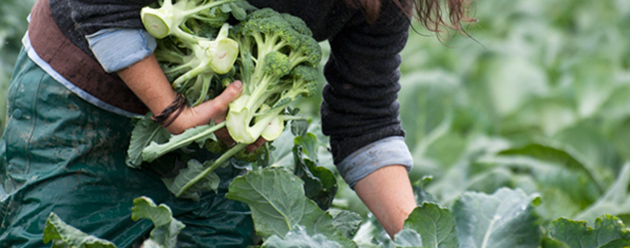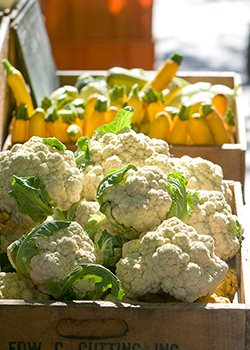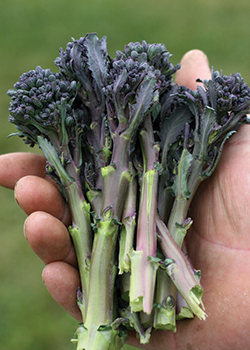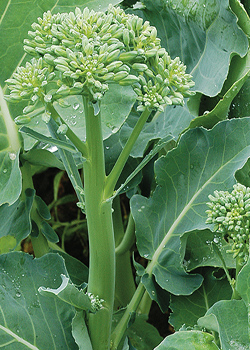- Artichokes
- Asparagus
- Baby Leaf
- Beans
- Beets
- Broccoli
- Brussels Sprouts
- Burdock
- Cabbage
- Carrots
- Cauliflower
- Celery & Celeriac
- Chicory
- Chinese Cabbage
- Collards
- Corn
- Cucumbers
- Eggplant
- Fennel
- Garlic
- Gourds
- Greens
- Horseradish
- Husk Cherry
- Kale
- Kalettes
- Kohlrabi
- Leeks
- Lettuce
- Melons
- Microgreens
- Mushrooms
- Okra
- Onions
- Parsnips
- Peas
- Peppers
- Potatoes
- Pumpkins
- Radishes
- Rutabagas
- Scorzonera & Salsify
- Shallots
- Shoots
- Spinach
- Sprouts
- Summer Squash
- Sweet Potatoes
- Swiss Chard
- Tomatillos
- Tomatoes
- Turnips
- Watermelons
- Winter Squash
Success with Brassicas:
Tips on Timing, Temperature, Fertility & Watering
Johnny's has been researching, trialing, and selecting brassicas for the better part of 50 years. As our appreciation grows for the diversity, flavor, and nutritional benefits offered by this family of crops—also known as the crucifers or cole crops—so, too, has market demand for different, better options shot up.
For fresh market growers, providing a steady supply of the new brassica superstars can thus be very rewarding. But growing brassicas successfully can also be challenging. A host of issues can arise if proper attention is not given to timing, temperature, fertility, and watering, as well as pest and disease pressure.
If you're interested in successfully growing brassicas that are not just healthy, but beautiful and flavorful (and, if you grow for a living, profitable), it pays to get familiar with these basics.
Timing & Temperature with Brassicas
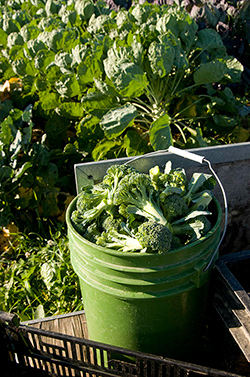
If timing is not everything with brassicas, it's because temperature and temperature fluctuations are also critical. Of all the environmental factors that regulate the development of brassica crops, timing and temperature are among the most critical. More about timing below.
Temperature predominates in the control of the individual plant's developmental transition between the vegetative phase (when stems and leaves, including the tightly wrapped heads of leaves develop) and the reproductive phase (when the heads of flower buds, florets, and flowers develop). Brassicas harvested before the reproductive phase include Brussels sprouts, flower sprouts, cabbage, Chinese cabbage, and kale. When the transition is unwanted or premature and the plant goes to seed before becoming marketable, it is called bolting.
Given a grower's limited ability to control temperature in the field, working in tune with nature to get the timing and temperature right is key. Whether the desired stage of your brassica harvest is leafy or reproductive or somewhere in-between, following these tips on timing and temperature will benefit flavor, yield, and quality.
The Case for Brassica Planting Programs
Planting programs are succession planting plans that make use of different varieties for different seasonal slots. Planting programs work because of differences in how varieties respond to changes in temperature and daylength; it is preferable to grow a series of different varieties in sequence, rather than simply repeating the very same variety across the entire breadth of your growing season.
- Brussels sprouts planting program
- Cauliflower planting program
- Heading broccoli planting program
- Mini and sprouting broccoli planting program
Critical Development Periods in Broccoli & Cauliflower
Planting varieties that are appropriately bred for and adapted to each seasonal window or slot can help prevent some developmental disorders and mishaps.
- Riceyness and interior bract formation. When the plants are immature, very warm or hot periods and/or periods of inadequate moisture can result in heads that are malformed: "ricey," pale in color, uneven, and generally unmarketable. If you plan on growing crops in warm weather (mid to high 80’s), choosing varieties appropriate for your area can help you avoid these problems. In our broccoli trials, for example, 'Imperial' and 'Monty' have demonstrated the most heat tolerance. In our cauliflower trials, the loose-curd 'Song TJS-65' has tolerated periods of heat better than standard white-stemmed varieties. For more information on cauliflower production in temperate/frost-free zones, see this guide from the University of California.
- Buttoning up. This term refers to the premature formation of small, unmarketable heads. Buttoning up can be caused by several nights of exposure to temperatures below 50°F (10°C) after transplanting. Broccoli and cauliflower are more sensitive to cold than many of their cabbage family relatives. Avoid buttoning by transplanting at the proper time in your area. Adequate water and row covers can also help the developing plants withstand cold spells.
- Challenges of fluctuating spring temps. There is a reason why so many brassicas are grown in the mild, even-temperature areas of California: most of the varieties available today are bred for these conditions and will not tolerate high levels of heat (mid to high 80’s) or widely fluctuating temps. Heat and radical changes in temperature can cause broccoli and cauliflower plants to produce heads that are of low quality and unmarketable. Cabbage and Chinese cabbage, in comparison, are not affected nearly as much by the vagaries of the weather and will still form good heads except when the heat is extreme.
- Getting the timing right for a mature late crop. Whether you're aiming for an early, midseason, or late harvest date, timing is critical. When targeting a late date, planting a bit earlier than ideal is usually better than planting a little too late. When planted a bit on the early side, the crop may be exposed to more later-summer heat than desired, but because this exposure will occur before head formation (for cabbage, broccoli, and cauliflower), the effect of the heat will not usually cause a problem. Planting too late, however, can result in the loss of the crop if the crop does not mature before the onset of cold, fall weather.
- Vernalization of 'Bonarda' Late-Sprouting Broccoli. Vernalization is only needed for ‘Bonarda'. The other mini broccolis in Johnny’s assortment do not need to be vernalized. Head formation in what many refer to as the sprouting broccolis is initiated by exposure to temperatures at or below 50°F (10°C) (but above 20°F /-7°C) over a period of several weeks. What that means is that these varieties will only form the desired heads after they've been vernalized by exposure to these cool temperatures. Johnny’s offers the late-sprouting broccoli variety ‘Bonarda,’ for late summer or early fall planting to overwinter and harvest in early spring, particularly in the Maritimes and Mid-Atlantic.
Frost & Flavor
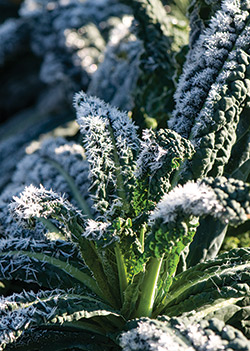
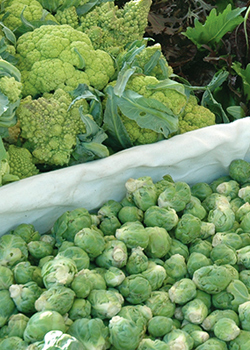
When grown in warmer climes where they are not exposed to cold, many brassica crops are simply not as sweet-tasting as those grown in cold weather. Particularly with kale and Brussels sprouts, exposure to cold is what will set your crop above the ho-hum flavor of those that have not had cold exposure.
How cold is cold, when we say "cold tolerant"?
Cold tolerance and hardiness are a relative terms rather than having precise definitions. A sudden cold snap that occurs in early fall, or before a crop has been exposed to much cold, might severely damage it. The same temperatures in late fall, after much more gradual exposure to cold, will cause much less damage. Furthermore, cold damage is cumulative. Five cold snaps can cause far more damage than one.
Different crops, and within them different varieties, have varying tolerances to cold. Of all the brassicas, the crops with the best cold tolerance include kale, collards, Kalettes, and Brussels sprouts, followed by cabbage, broccoli, and cauliflower.
Are Summer Brassicas Worth Your While?

So, if brassicas are so temperature-sensitive, is it even worthwhile to plant "summer brassicas"?
No one can predict the weather of an upcoming season, but following a planting program and keeping a record of your outcome can help ensure a steadier supply across the growing seasons.
Precisely because there are so many variables we cannot control, we've developed our brassica succession planting programs to work with nature, and based them on data sets from multiyear, multilocation trials. Our goal is to provide adaptable options that allow you to have a broader, higher-yielding brassica harvest window.
"Heat-tolerant" varieties will do reasonably well in most places, unless heat and humidity are excessive. In addition to the varieties specifically called out in our planting programs, there are some other brassica types and varieties known for good summer performance.
- Cabbage. Cabbages tolerate heat better than most brassicas but still perform best in cooler temperatures. That being said, Johnny’s does offer a number of varieties that perform particularly well under summer conditions. 'Caraflex', 'Picadilly', and 'Tendersweet' perform very well and have notably superior eating quality.
- Collard Greens. This is a crop that is not bothered by heat unless it is excessive, such as in the Southeast and Deep South. In the Deep South collards are typically transplanted in August through late September for fall, winter, and early spring crops. It is usually too hot to grow in midsummer. As noted above, collards also have good cold tolerance, and their flavor can be improved by cooler temperatures. Though not traditionally grown in cooler, northern areas, collards perform very well in those regions.
- Mini Broccolis. The "summer-sprouting" mini broccolis are generally chosen for the varietal characteristics we note in our product descriptions. 'Happy Rich' offers very good flavor with an excellent yield potential. Of the broccoli raabs, 'Spring Raab' is suitable for early crops. In the different parts of the growing season these varieties perform similarly here in Central Maine, and are generally not bothered by heat unless it is excessive, such as in the Southeast and Deep South. In the the Deep South these would have to be harvested in very early summer from a late winter/early spring planting or they could be planted in fall for winter crops.
Fertilizing Brassicas
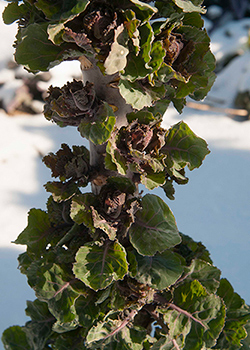
The bicolor rosettes of 'Autumn Star' require a minimum of 110 days to mature, from time of transplanting.
Start with a soil test. Brassicas are heavy feeders, requiring relatively high levels of nitrogen. If your soil has adequate fertility, no fertilization will be required during the growing season. If your soil is lacking in fertility, then side-dressing with compost or a slow-release organic fertilizer is recommended. Your soil test results will likely give you helpful recommendations on application rates.
Taking care not to damage the roots of the plants, hoe in the compost or fertilizer; otherwise, some of the nitrogen will be lost.
To encourage head/sprout production, or to minimize growth going into dormancy, stop fertilizing in mid summer, so that the plants grow more slowly and "toughen up" for fall.
Late-summer fertilization will result in plants growing too quickly into fall. These plants will be too lush and tender, and more susceptible to frost and cold damage. This is particularly important for crops such as Brussels sprouts, Flower Sprouts/ Kalettes, cabbage, and sprouting broccoli that will be harvested deep into fall, and even winter or spring.
Irrigating Brassicas
Brassicas require adequate water to perform well. Plant brassicas where you can irrigate consistently throughout the growing season. Generally, brassicas perform best when given 1” of water per week. Consistency of irrigation is also important and will result in healthier more productive crops than those that are allowed to become excessively dry between waterings.
Brassicas in Abundance
Growers all over the world over many generations have been applying their ingenuity to mitigate the effects of temperature extremes on their brassica crops. For common practices used to offset high temperatures, see Getting Your Cold-Loving Crops Through the Heat of Summer. To learn more about methods employed through the colder months, see Johnny's Winter Growing Guide.
There are also myriad ways to mitigate pest and disease pressure on brassica yield and quality. To learn more, read our review and additional resources on Common Brassica Pests & Diseases.
As more people come to value all that the brassicas have to offer, demand for a steady supply of these crops will continue to increase. Each year over many years, the goal of our research, trialing, and selection programs is to offer the most flavorful, best-performing varieties for fresh market farmers and home gardeners. Whether you're new to this vegetable family or a seasoned grower, we hope our selection serves your needs throughout the year. With good planning, quality seed, and sound cultural practices, your brassica program can be very rewarding.


